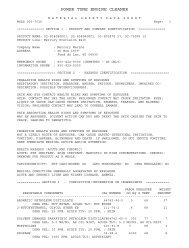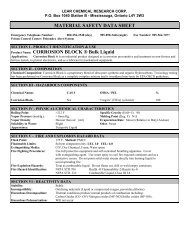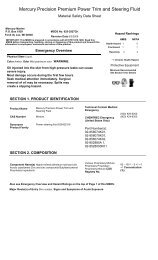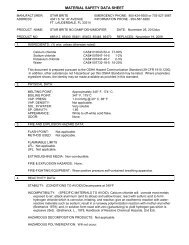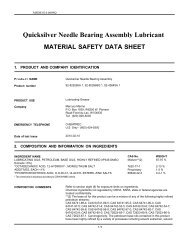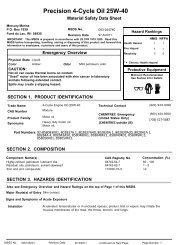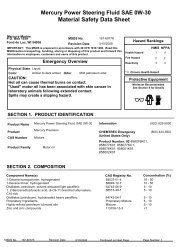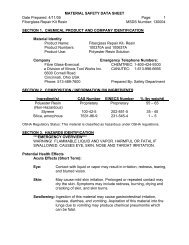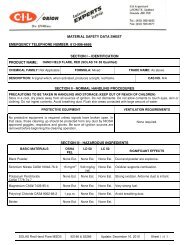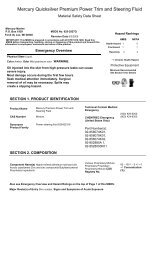Quicksilver Rejuvenate 2-Cycle Engine Oil - Mercury Marine
Quicksilver Rejuvenate 2-Cycle Engine Oil - Mercury Marine
Quicksilver Rejuvenate 2-Cycle Engine Oil - Mercury Marine
Create successful ePaper yourself
Turn your PDF publications into a flip-book with our unique Google optimized e-Paper software.
<strong>Mercury</strong> <strong>Rejuvenate</strong> 2-<strong>Cycle</strong> <strong>Engine</strong> <strong>Oil</strong><br />
SECTION 7. HANDLING AND STORAGE<br />
Handling<br />
A spill or leak can cause an immediate fire or explosion hazard. Keep containers closed and<br />
do not handle or store near heat, sparks, or any other potential ignition sources. Avoid<br />
contact with oxidizing agents. Do not breathe vapor. Use only with adequate ventilation and<br />
personal protection. Never siphon by mouth. Avoid contact with eyes, skin, and clothing.<br />
Prevent contact with food and tobacco products. Do not take internally.<br />
When performing repairs and maintenance on contaminated equipment, keep unnecessary<br />
persons away from the area. Eliminate all potential ignition sources. Drain and purge<br />
equipment, as necessary, to remove material residues. Follow proper entry procedures,<br />
including compliance with 29 CFR 1910.146 prior to entering confined spaces such as tanks<br />
or pits. Use gloves constructed of impervious materials and protective clothing if direct<br />
contact is anticipated. Provide ventilation to maintain exposure potential below applicable<br />
exposure limits. Use appropriate respiratory protection when concentrations exceed any<br />
established occupational exposure level (See Section 8). Promptly remove contaminated<br />
clothing. Wash exposed skin thoroughly with soap and water after handling.<br />
Non equilibrium conditions may increase the fire hazard associated with this product. Always<br />
bond receiving containers to the fill pipe before and during loading. Always confirm that<br />
receiving container is properly grounded. Bonding and grounding alone may be inadequate to<br />
eliminate fire and explosion hazards. Carefully review operations that may increase the risks<br />
such as tank and container filling, tank cleaning, sampling, gauging, loading, filtering, mixing,<br />
agitation, etc. In addition to bonding and grounding, efforts to mitigate the hazards may<br />
include, but are not limited to, ventilation, inerting and/or reduction of transfer velocities.<br />
Always keep nozzle in contact with the container throughout the loading process. Do NOT fill<br />
any portable container in or on a vehicle. Do NOT use compressed air for filling, discharging<br />
or other handling operations.<br />
Storage<br />
Product container is not designed for elevated pressure. Do not pressurize, cut, weld, braze<br />
solder, drill, or grind on containers. Do not expose product containers to flames, sparks, heat<br />
or other potential ignition sources. Empty containers may contain product residues that can<br />
ignite with explosive force. Observe label precautions. Consult appropriate federal, state and<br />
local authorities before reusing, reconditioning, reclaiming, recycling or disposing of empty<br />
containers and/or waste residues of this product.<br />
Keep container tightly closed. Store in a cool, dry, well-ventilated area. Store only in<br />
approved containers. Do not store with oxidizing agents. Do not store at elevated<br />
temperatures or in direct sunlight. Protect containers against physical damage. Head space<br />
in tanks and other containers may containers may contain vapor in the flammable range.<br />
Vapor may be ignited by static discharge. Storage area must meet OSHA requirements and<br />
applicable fire codes.<br />
Additional information regarding the design and control of hazards associated with the<br />
handling and storage of flammable and combustible liquids may be found in professional and<br />
industrial documents including, but not limited to, the National Fire Protection Association<br />
(NFPA) publications NFPA 30 ("Flammable and Combustible Liquid Code"), NFPA 77<br />
("Recommended Practice on Static Electricity") and the American Petroleum Institute (API)<br />
Recommended Practice 2003, “Protection Against Ignitions Arising Out of Static, Lightning,<br />
and Stray Currents' (liquids)."<br />
SECTION 8. EXPOSURE CONTROLS AND PERSONAL PROTECTION<br />
<strong>Engine</strong>ering Controls<br />
Provide exhaust ventilation or other engineering controls to keep the airborne concentrations<br />
of mists and/or vapors below the recommended exposure limits (see below). An eye wash<br />
station and safety shower should be located near the work-station.<br />
MSDS No. 625431316 Revision Date 6/3/2009 Continued on Next Page Page Number: 4



